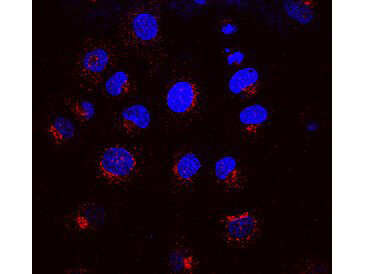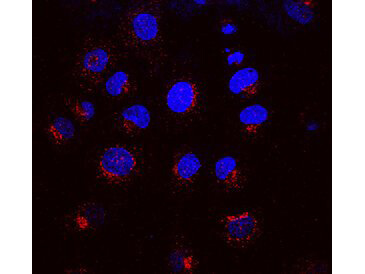
KDEL Receptor Antibody
Product Sizes
100 ug
500-301-F86-100UG
About this Product
- SKU:
- 500-301-F86
- Additional Names:
- KDELR1|mouse anti-KDEL Receptor Antibody, ERD2, ERD2.1, ERD21, HDEL, KDEL, KDEL R1, KDELR1, PM23, Lys Asp Glu Leu, K-D-E-L, ER lumen protein retaining receptor 1, KDEL endoplasmic reticulum protein retention, Kdelr1
- Application:
- Immunofluorescence, Immunohistochemistry, Immunoprecipitation, Western Blot
- Buffer:
- 0.02 M Potassium Phosphate, 0.15 M Sodium Chloride
- CE/IVD:
- RUO
- translate.label.attr.clone:
- KR-10
- Clonality:
- Monoclonal
- Concentration:
- 1 mg/ml
- Extra Details:
- The endoplasmic reticulum is part of a protein sorting pathway, or in essence, the transportation system of the eukaryotic cell. The majority of endoplasmic reticulum resident proteins are retained in the endoplasmic reticulum through a retention motif. This motif is composed of four amino acids at the C-terminal end of the protein sequence. The most common retention sequence is KDEL (lys-asp-glu-leu). However, variation on KDEL does occur and other sequences can also give rise to endoplasmic reticulum retention. There are three KDEL receptors in mammalian cells, all have a very high degree of sequence identity; and all are located within the cis-Golgi and its intermediate compartments. In terms of function, KDEL receptors interact with GAP (GTPase-activating protein) of ARF1, which is involved in COPI dependent vesicle transport, and the KDEL receptor may also be responsible for the recruitment of this ARF1 to membranes which can then aid in the regulation of vesicle budding. It is also important to note that the KDEL receptor exhibits extensive sequence identity o yeast protein Erd2p, which is a receptor for the yeast ER retention signal.
- Format:
- Ascites
- Formulation:
- 0.02 M Potassium Phosphate, 0.15 M Sodium Chloride, pH 7.2
- Host:
- Mouse
- Immunogen:
- KDEL Receptor Antibody was produced in mice by repeated immunizations raised against a 21 residue synthetic peptide based on the bovine KDEL receptor and the synthetic peptide coupled to KLH.
- Isotype:
- IgG1
- Physical State:
- Liquid
- Reactivities:
- Amphibian, Avian, Bovine, Canine, Hamster, Human, Insect/Arthropod, Mouse, Non-human Primate, Porcine, Rabbit, Rat, Sheep
- Shipping Conditions:
- Dry Ice
- Specificity:
- Anti-KDEL Antibody is clarified mouse ascites fluid. A BLAST analysis was used to suggest cross-reactivity with KDEL from Human, Monkey, Rat, Mouse, Hamster, Rabbit, Pig, Bovine, Sheep, Canine, Chicken, Drosophilia, and Xenopus based on 100% homology with the immunizing sequence. Cross-reactivity with KDEL from other sources has not been determined. Chaperones, Organelle Markers research.
- Storage Conditions:
- -20[o]C aliquoted. Aliquot. Avoid freeze/thaw cycles.
- Supplier:
- Rockland Inc
- Type:
- Antibody: Monoclonal Antibody
- Manufacturer's Data Sheet:https://www.rockland.com/search/?searchString=500-301-F86




